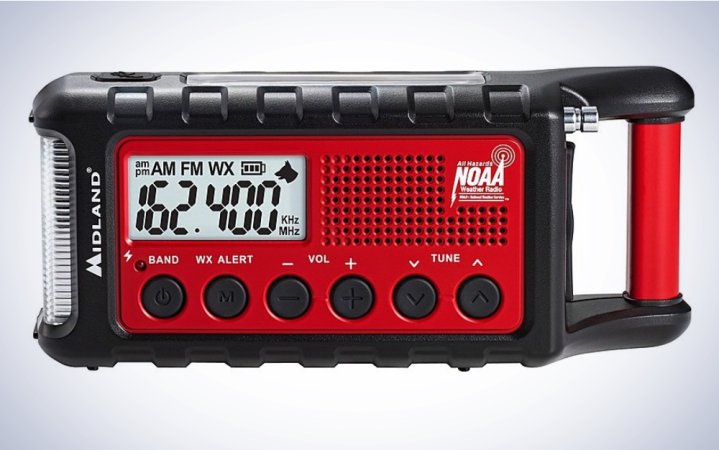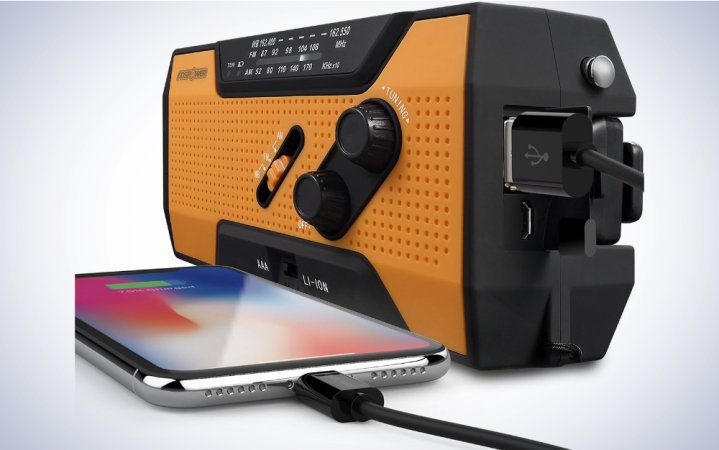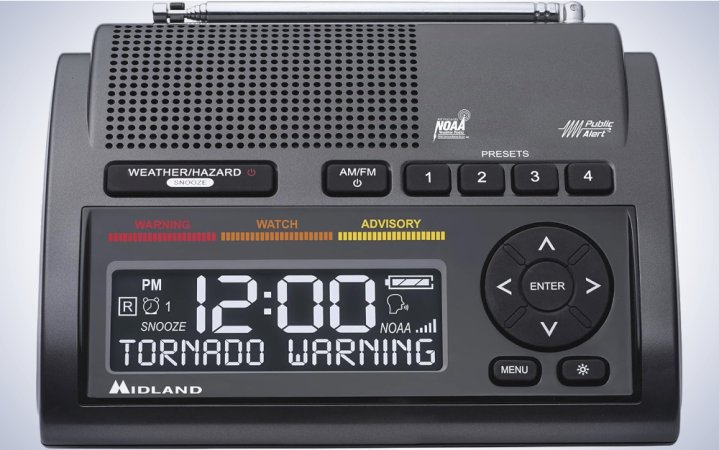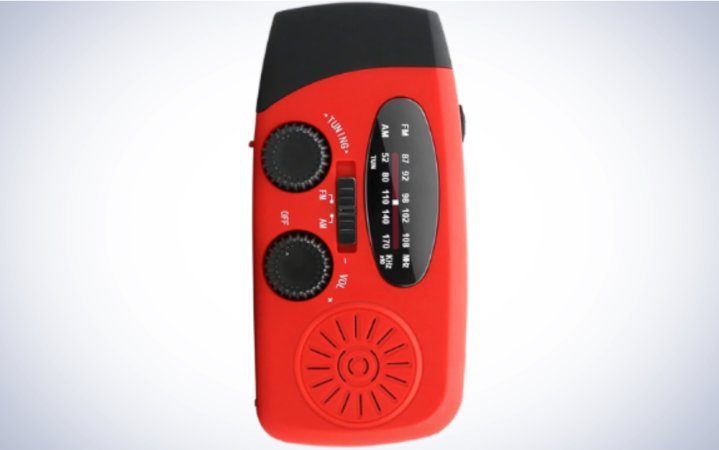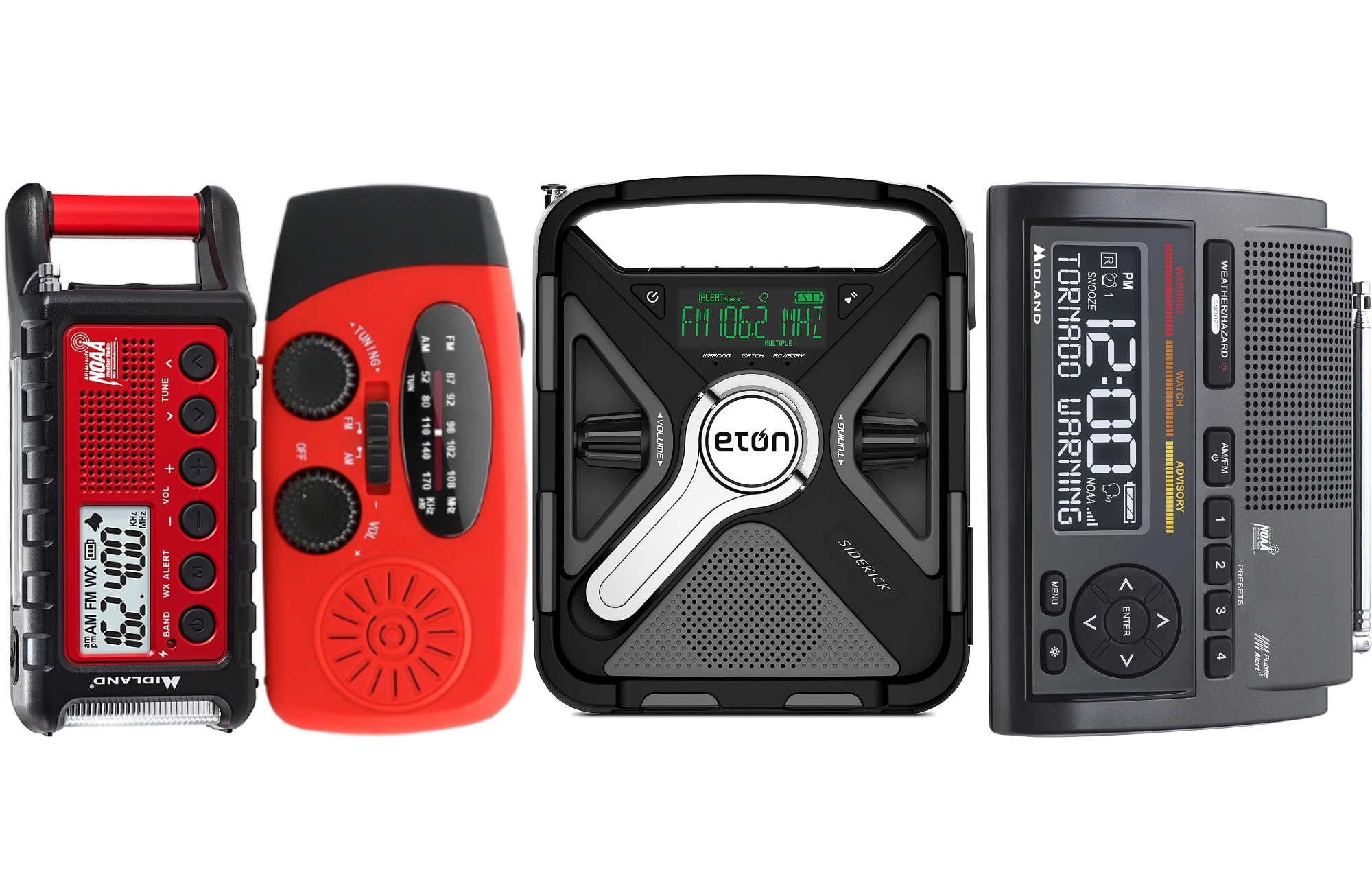

We may earn revenue from the products available on this page and participate in affiliate programs. Learn more ›
Whether you’re facing a hurricane or tornado, a blizzard, or an earthquake, you may want what we call a “weather radio” to keep you and your family well-informed throughout the ordeal. These radios can keep you updated and act as emergency radios after you’ve been hit. Plus, there’s nothing wrong with a bit of music or talk radio to keep you entertained after the storm has left you without power. A weather radio is also a smart bit of outdoor gear because you don’t want to get caught unprepared when you’re exposed. But what’s out there for you to get to make sure what’s out there doesn’t get you? Here, we explore the best weather radios to help you weather a storm.
- Best overall: Midland E+Ready
- Best for cars: FosPower Emergency Weather Radio
- Best for home alerts: Midland WR400 Deluxe NOAA Weather Radio
- Best splurge: Eton Sidekick
- Best budget: Running Snail Hand Crank Radio
How we chose the best weather radios
Weather radios need to be able to survive a storm even if your power doesn’t (though we always recommend keeping a topped-off solar generator on hand, just in case). They function to serve you through storms that can cause disruptions in utilities and other services. The radios we selected meet these requirements above all others.
The best weather radios: Reviews & Recommendations
The following radios should be able to get you through almost any storm. They have been selected for having a wide variety of powering mechanisms and their usefulness in various situations. They won’t have the sound quality of the best Bluetooth speakers, but when you need a radio that can get you through a common thunderstorm or intense weather events, you’ll find something on this list.
Best overall: Midland E+Ready
Why it made the cut: This weather radio has a bit of everything, plus it is one of the best-rated weather radios at online retailers.
Specs
- Charging mechanisms: USB charging, AA, hand crank, solar
- NOAA access: Yes
- Battery life: 32 hours (Infinite with hand crank)
- Size: 3.4 x 8 x 2.4 inches
- Bonus features: Segmented display, flashlight, SOS alarm, ultrasonic dog whistle, power bank
Pros
- Excellent form factor with handle
- Big, easy press buttons
- Dog whistle emergency alert
- Morse code flashlight beacon
Cons
- Mildly expensive
The Midland E+Ready is one of the most favored emergency weather radios on the market. Its large buttons are intelligible and workable even by those who are nervous, have big thumbs, or have arthritis. Its large segmented display will further make it usable to those who need big readouts. We particularly appreciate it for its WX alert button, which quickly changes to National Oceanic and Atmospheric Administration (NOAA) weather alert readouts.
Should you be using this radio while camping or hiking as part of one of your fully built survival kits, further survival features come from its SOS flashlight beacon, which can alert people visually to your location as well as send Morse code messages. There is also an ultrasonic dog whistle to alert rescue dogs to your location should the worst occur.
However, it would be best if you didn’t discount this handy machine for at-home use, either. It has a sturdy base, low and high flashlight settings for navigating your darkened home after a power outage, and a power bank to charge your phone enough to make an important call. And, of course, it has the NOAA weather radio readouts, which is what you want a weather radio for in the first place.
While the Midland E+Ready has multiple charging mechanisms, we recommend you charge its 2600 mAh battery to full ahead of time. It’ll get you through about 32 hours of radio use with little extra effort. You can also crank the radio or (if you have the sunlight) charge it via solar panels. Finally, there is the battery-operated option, using AA batteries, but the six required to charge it seems somewhat excessive.
Best for cars: FosPower Emergency Weather Radio
Why it made the cut: Stuffing this radio under the driver’s seat can prep you for the next storm in more ways than one.
Specs
- Charging mechanisms: AAA, USB charging, hand crank, solar
- NOAA access: Yes
- Battery life: Infinite with hand crank
- Size: 6.2 x 2.1 x 2.9 inches
- Bonus features: Flashlights, SOS alarm, power bank
Pros
- Intense power bank
- IPX3 water resistant
- Glove box size
- Includes SOS alarm
Cons
- Lengthy initial charge time
As you’re building your emergency car kits, you’ll want access to NOAA radio that your car very well might not be able to receive, plus extra goodies that can get you through the storm while pulled over. This FosPower radio has everything you need to keep your car battery (and gas supply) good while also helping you out in other ways in a pinch.
It’s compact enough to fit in your organized glovebox, for one, so it’ll always be a moment’s reach away. During heavy rains, when you should pull over, you can turn your car off, use your FosPower radio instead, and use its reader light for some novel entertainment. Decide to dash for home anyhow? Not only is the FosPower IPX3 water-resistant, but it also has a handy flashlight, allowing you to safely find your way to your door even when your power is out.
And while we’re not saying this is the only piece of equipment you’ll need while trying to figure out how to survive a snowstorm inside your truck, there are some features that will help you in this case. It has a pretty intense power bank that can charge your phone (alongside a crank if you need more power) and it has an SOS siren that can alert people to your location.
Best for home alerts: Midland WR400 Deluxe NOAA Weather Radio
Why it made the cut: This weather radio for home use is perfect for tornado and thunderstorm alerts.
Specs
- Charging mechanisms: Outlet, 4 x AA
- NOAA access: Yes
- Battery life: ~4-8 hours
- Size: 7 x 5.5 x 2.2 inches
- Bonus features: Segmented display, SAME tech, Siren
Pros
- Advanced NOAA features
- Helpful weather-oriented display
- Loud alert alarm
- Easy-to-use interface
Cons
- Limited powering options
- Lacks durability
Midland’s WR400 Deluxe is built especially for those who want a stationary, at-home weather radio with an intuitive readout and many dedicated weather features. The WR400 provides instant NWS reports, has NOAA ‘SAME’ tech for region-specific reports, and features an 85dB siren for emergency alerts. Its segmented display includes regions for warning/watch/advisory alerts and written-out alerts to give you specifics. In other words, knowing what’s happening in your area only takes one look.
This radio is meant to be kept with you, plugged into your bedroom’s wall socket, possibly working as your morning commute alarm, too. Its alternative powering mechanism is a somewhat outdated four AA batteries, though you can get some of the best rechargeable batteries to counteract this somewhat. In light of this, this radio will best serve people worried about tornadoes and thunderstorms over conditions like flooding and hurricanes. But if that’s your use case, it’s the best value.
Best splurge: Eton Sidekick
Why it made the cut: While on the expensive side, it has robust features and a quality build.
Specs
- Charging mechanisms: USB, hand crank, solar
- NOAA access: Yes
- Battery life: Infinite with hand crank
- Size: 7.8 x 2.9 x 12.7 inches
- Bonus features: Segmented display, light, emergency beacon, SAME technology, large power bank
Pros
- Sturdy build with great handle
- IPX4 water resistance
- Easy to use
Cons
- Expensive
Eton’s Sidekick is an adventurer’s weather radio with a strong build, good handles, and enough water resistance to ward off a sprinkle. It is also NOAA-ready with SAME technology for county-specific broadcasts. If you’re on the go, you can either pack it in your backpack or carry it with you as you hike through easier sections of the trail.
The hand crank on the Sidekick is in a nice, central location, and you should feel a sense of balance as you spin it. The handles and empty spaces around the edge give you multiple ways of securing it while you crank, too, so it should be quite easy to steady. According to Eton, you’ll get 10 to 15 minutes of charge from a 4-minute cranking session, though your mileage will, of course, vary. For example, if you’re shining the huge light on its side at full blast, expect less time.
Best budget: Running Snail Hand Crank Radio
Why it made the cut: This small radio gets it done at a low price.
Specs
- Charging mechanisms: USB, Hand Crank, Solar
- NOAA access: Yes
- Battery life: Infinite with hand crank
- Size: 5 x 1.8 x 2.4 inches
- Bonus features: Flashlight, effective power bank
Pros
- Can charge your phone in a pinch
- Small and lightweight
- “Afterthought” tier pricing
- Emergency flashlight attached
Cons
- Very simple
This weather radio, while cheap and simple, shouldn’t be overlooked. Its fit-in-your-pocket size, half-pound weight, and low price make it a quick pickup for many situations. It can certainly be used as a backup weather radio for even the most prepared families.
While it does have NOAA access, the most important part of this radio is its combination of hand crank power and phone charging. Even when we have extensive portable power banks, the scarcity mindset can kick in, and we won’t want to use up the power except for the most necessary phone calls. However, with RunningSnail’s small emergency weather radio, that all changes, as you can crank your way to enough power for a phone call whenever you need to do so. In the calm after the storm, you can also grab some solar power.
Again, this radio is so small and so affordable that it can be logical to buy as a backup for your car, camping bag, or even your backpack and purse should you wind up somewhere without phone power and no other ways to charge up. If you live in an area prone to sudden storms, this would also work as your piece-of-mind tech option with no exorbitant price. Plus, it’s an eco-friendly workout.
What to consider before buying weather radios
Radios aren’t extremely complicated devices; that much is known. That’s why the best weather radios do something to distinguish themselves as having something special for you during emergencies. Here’s an overview of what to look for.
NOAA radio access
What makes a weather radio a weather radio? Many argue that it is the inclusion of NOAA radio access. The National Oceanic and Atmospheric Administration hosts one of the US’s most consistent and up-to-date radio weather broadcasts, with many local variations throughout the country.
Many such radios have access to NOAA-adjacent features, such as NWR SAME and the Emergency Alert System. These features give broadcast info based on local needs and help alert you to emergencies, with SAME alerting you based on a specific county you select. One of the most interesting and weather-specific NOAA-equipped radio features is the tone-alarm feature, which will alert you via the radio even when the radio’s volume is turned off.
Since NOAA is on a special frequency band, it is unavailable on all radios. Does this mean that other radios are worthless as weather radios? Not necessarily. You can still access the National Weather Service online, and online NOAA broadcasts exist as well. Plus, if you live in areas during times of exceptionally bad weather—such as Florida’s hurricanes—you can expect local radio stations to be covering the events as well, often with on-the-ground reporting. Still, though, having NOAA access is worth it.
Quality powering mechanism(s)
There are a ton of ways to charge a radio these days. You can use batteries, an internal battery with USB-C charging, hand cranks, and even solar panels to get your radio alert-ready. However, just because these mechanisms will work, it doesn’t mean that all of them are made equal and that you need to rely on just one.
Internal batteries are the most convenient, reduce moving and losable parts, and are very trustworthy. And they last longer than AA or AAA batteries without corrosion. They do require power to recharge, however. A battery life of 12 to 24 hours will get you through most storms, but extended power outages and emergency weather situations will require more power. You can mitigate this by having a portable charger handy, but a secondary power source is even better.
Hand cranks are an incredibly popular power source and are an excellent primary power source for most people. However, make sure that cranking will provide extended power so you won’t need to crank the radio repeatedly while using it, as this could prove very annoying. Secondly, remember accessibility concerns, as those with motility issues (or, worst come to worst, injuries from the storm) may not be able to crank the radio reliably.
Finally, we’d like to caution you against relying solely on solar power despite the prevalence of this alternative charging mechanism in the best weather radios. It’s a romantic notion. You lose power and use the sun to get radio information about your situation. However, storms also happen at night and tend to come with dampened skies even during the day. Don’t let a romantic notion leave you unprepared. There’s nothing wrong with solar panels, but don’t let them be your only power source.
Hardiness
The primary concern you’ll have for your radio’s safety is its ability to withstand a drop. Things to look for include protective coatings, strong exteriors, and quality handles that reduce the chance of a drop in the first place. Consulting the world of real-world reviews is also quite important. If you start to see multiple consumers giving a product the “I dropped it once, and it never worked again.” treatment, that’s vital information that reveals the product has an unstable build.
Another thing to look at is water protection or “water-proofing,” as it might also be called. The most reliable method of determining a device’s water protection is its Ingress Protection Rating, more commonly called an IP rating. You may see something like IPX4 or IP68, with the right-most digit being more important. The first hypothetical device, with a water protection rating of 4, will be fine if you’re camping and get it briefly in the rain. The second, with a water protection rating of 8, has the highest protection rating and is good if you expect flooding, as it can withstand a dip in the water.
Additional weather and survival features
After automatic NOAA turn-on, one of the most commonly seen things on weather radios is additional USB ports for giving your phone or other devices a quick charge, effectively making the radio a power bank. While this can drain your radio battery down, it can certainly be worth it if your phone is the more important device at the moment.
You may also find that your weather radio has additional capabilities. For example, it may include a flashlight feature or an extensive power bank for your other devices.
FAQs
A weather radio can cost anywhere from about $30 to just over $80. Generally speaking, we don’t recommend buying a weather radio that costs much over $100 as it may be trying to do too many things (have too many extras) when you might get better quality and fairer pricing from buying a couple of items instead.
Weather radios last as long as any other radio. Keeping your radio safe, checking and changing replaceable AA and AAA batteries before corrosion sets in, and using smart battery-recharging strategies will all extend the life of your weather radio.
Crank radios are absolutely worth it in case of emergency situations. This being said, it is highly encouraged to have a secondary charging mechanism (such as a USB-C charge port) to make the radio even more convenient to use, though this is optional. Finally, make sure any potential users of the radio have the ability to physically crank the radio comfortably, as there could be potential accessibility issues for those with some disabilities.
Final thoughts on the best weather radios
- Best overall: Midland E+Ready
- Best for cars: FosPower Emergency Weather Radio
- Best for home alerts: Midland WR400 Deluxe NOAA Weather Radio
- Best splurge: Eton Sidekick
- Best budget: Running Snail Hand Crank Radio
The best weather radios are not much different from a technical standpoint than standard radios but will typically have NOAA access and more extensive charging and power options. Remember to choose a radio that will get you through a storm and perform in various situations over one that will just deliver today’s hits with the best sound quality possible.
